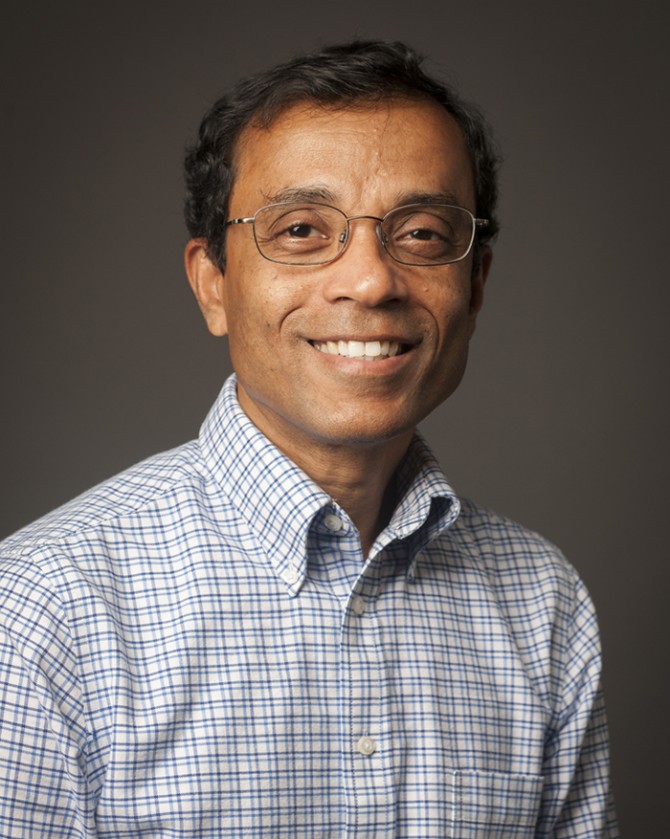$900K USDA grant will further study of food physics and manufacturing
By Tom Fleischman
Drying, frying, baking and puffing are just a few common processes in the vast world of industrial food. And though the foods they alter are countless – potato chips, popcorn, French fries – all these core processes are unified by a set of universal physical laws.
Developing a framework for understanding the physics of food processing and designing simulation models that can pinpoint optimal methods for cooking, preserving, packaging and more is how Ashim Datta has spent his career.
But in 1985, when Dattapresented his doctoral dissertation on Mathematical Modeling of Natural Convection Heating of Foods, it was met with skepticism. He claims that an audience member – a professor in the discipline from an elite university – told him, “We wouldn’t give you a Ph.D. for that.” Datta earned his doctorate in agricultural engineering that year from the University of Florida, and one year later began his career as an assistant professor at Cornell.
Fast forward 30 years, and the world seems to have caught up with Datta’s work on the physics of food preparation. “I have just in the last month or so heard from three companies who are trying to work with me on these models,” he said recently.
Datta, professor in the Department of Biological and Environmental Engineering, recently got a major funding boost for his research, as well – a $905,000 grant from the U.S. Department of Agriculture’s National Institute of Food and Agriculture program. Datta’s project – “Enabling Computer Aided Food Product and Process Design For Everyone” – has several Co-PIs from Cornell as well as national and international institutions.
“This is not new,” he said of his use of computer and mathematical modeling to improve manufacturing. “This started in the aeronautical industry in the 1970s, automotive industry in the 1980s and is now beginning to be of significant interest in the food industry.
“This is all I did for the last 30 years, so for me this [USDA grant] is very special,” said Datta, who in 2014 was named a Stephen H. Weiss Presidential Fellow, Cornell’s top teaching award. “Nobody seemed to care, but it was actually ahead of its time.”
While cooking, frying and baking seem like totally separate things, there is underlying physics that relates to all three, Datta said.
“If you know the underlying physics,” he said, “you can move around between products and processes, and you can understand from one and translate to another.”
It’s an unconventional way for an engineer to go about his business, Datta said. Researchers working with food are often chemists or microbiologists who apply those disciplines to food quality or processing, or they approach the understanding experimentally. But the physics of food, and mathematical modeling of food processes? Not so much.
Much research and development in the food industry is based on trial and error, Datta says – “cook and look,” it’s sometimes called. Resources are wasted trying out one process or another until it’s optimized – for example, the exact time and temperature needed to deep-fry partially frozen French fries.
For one project, Datta analyzed the process of baking from a first-principles approach, seeking an optimization strategy for the exact mechanism by which a potato gets crisper during baking. The physical principles are general enough to apply to frying as well.
“Universal physical laws apply to processes as varied as grilling of meat or puffing using microwaves,” Datta said. “But such universal physics framework has not been developed for food, and that has been our overall contribution in the field.”
Datta has also used puffing as a model for studying physics in food – think puffed rice cakes or potato chips. Puffing a potato involves heat, evaporation and pressure generation, and the materials undergo changes to allow expansion. At the Institute of Food Technology conference in New Orleans in 2014, Datta’s graduate student, Tushar Gulati, received an award for a presentation on a physics-based model of the rice puffing process.
Also in 2014, Datta led a multi-university project that received $683,000 from the USDA with a similar aim as the new grant: integrating the power of computer simulation with teaching food safety principles.
Much of the motivation for developing these frameworks is to enhance quality prediction for food.
“French fries have been around for a long, long time – why would you make a model for French fries?” he asked. “But you’re doing it by cook and look, trial and error, and then you scale up to thousands of pounds an hour or something, then you really have to control the process, you have to get it right. A little bit of a problem would mean a lot of cost and a lot of waste.
“By knowing these details,” he said, “you can get closer and closer to doing it in an automated, efficient way.”
Former Chronicle writer Anne Ju contributed to this story.
Media Contact
Get Cornell news delivered right to your inbox.
Subscribe

